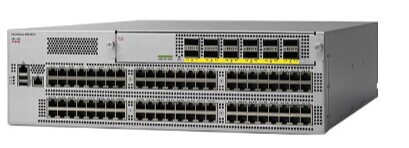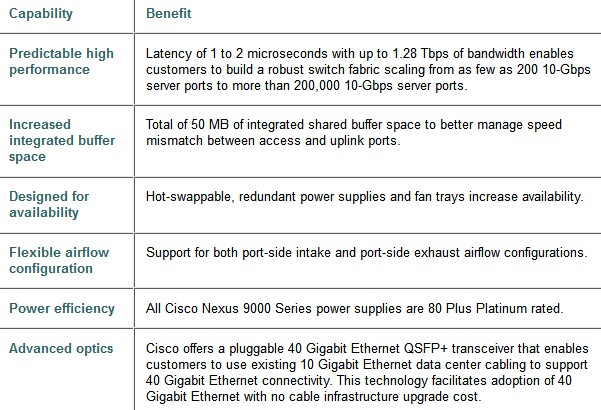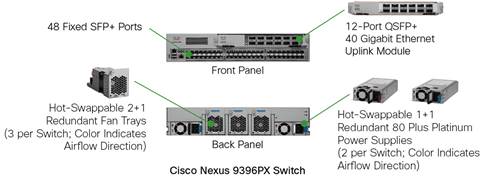
Cisco Nexus 9300 Series, the fixed-port switch, is one of the Nexus 9000 Series switches. It was designed for top-of-rack (ToR) and middle-of-row (MoR) deployment in data centers that support enterprise applications, service provider hosting, and cloud computing environments.
Cisco Nexus 9300 Series Switches are Layer 2 and 3 nonblocking 10 and 40 Gigabit Ethernet and Fibre Channel over Ethernet (FCoE)-capable switches with up to 2.56 terabits per second (Tbps) of internal bandwidth.
Firstly, we will look at the main three models of Cisco Nexus 9300 Series. What are they? Let’s see the following details.
Cisco Nexus 9300 Switch Models
| Model | Description |
| Cisco Nexus 9396PX Switch | 48×1/10Gbps SFP+ and 12x40Gbps QSFP+ ports |
| Cisco Nexus 9396TX Switch | 48×1/10G BASE-T and 12x40Gbps QSFP+ ports |
| Cisco Nexus 93128TX Switch | 96×1/10G BASE-T and 8x40Gbps QSFP+ ports |
The Cisco Nexus 9396PX Switch is a 2-rack-unit (2RU) switch that supports 1.92 Tbps of bandwidth across 48 fixed 10-Gbps SFP+ ports and 12 fixed 40-Gbps QSFP+ ports.
Cisco Nexus 9396PX Switch
The Cisco Nexus 9396TX Switch is a 2RU switch that supports 1.92 Tbps of bandwidth across 48 fixed 1/10GBASE-T ports and 12 fixed 40-Gbps QSFP+ ports.
Cisco Nexus 9396TX Switch
The Cisco Nexus 93128TX Switch is a 3RU switch that supports 2.56 Tbps across 96 fixed 1/10GBASE-T ports and 8 fixed 40-Gbps QSFP ports.
Cisco Nexus 93128TX Switch
The 40-Gbps ports for Cisco Nexus 9396PX, 9396TX and 93128TX are provided on an uplink module that can be serviced and replaced by the user. The uplink module is the same for all switches; If used with the Cisco Nexus 93128TX, 8 out of the 12x40Gbps QSFP+ ports will be available.
Note: Among the three nexus 9300 models, Nexus 9396PX and 93128TX switch are the Nexus 9300 Series ACI leaf switches.
The Cisco ACI fabric consists of three major components:
- Cisco Application Policy Infrastructure Controller (APIC)
- Spine switches
- Leaf switches
These three components handle both the application of network policy and the delivery of packets. Cisco Nexus9000 Series Switches, support Cisco ACI, and organizations can use them as spine or leaf switches to take full advantage of an automated, policy-based, systems management approach.
Cisco Nexus 9300 Series Switches, What’ new Here?
The platform offers industry-leading density and performance with flexible port configurations that can support existing copper and fiber cabling. With 1/10GBASE-T support, the platform can deliver 10 Gigabit Ethernet over existing copper, enabling a low-cost upgrade from Cisco Catalyst 6500 Series Switches when used in an MoR or EoR configuration.
Cisco Nexus 9300 Series Switches Capabilities
The Nexus 9300 switches are designed to adapt to any data center hot-aisle and cold-aisle configuration. They can be installed with ports facing the rear, simplifying cabling of server racks by putting the ports closest to the servers they support. The Cisco 9300 switches can be installed with the ports facing the front, simplifying the upgrade of existing racks of switches in which network cables are wired to the front of the rack. The two deployment modes support front-to-back cooling through a choice of power supplies and fan trays designed with opposite airflow directions, denoted by red and blue tabs.
To enhance availability, the platform supports 1+1 redundant hot-swappable 80 Plus Platinum-certified power supplies and hot swappable 2+1 redundant fan trays.
Cisco Nexus 9300 Series Switch Components
Cisco Nexus 9300 Series Uplink Module
The Cisco Nexus 9300 platform requires an uplink module to be installed for normal switch operation. The Cisco Nexus M12PQ uplink module provides up to 12 QSFP+ ports for 40 Gigabit Ethernet connectivity to servers or aggregation-layer switches. As specified earlier in Table 1, the uplink module provides 8 active ports when installed in the Cisco Nexus 93128TX, and 12 active ports when installed in the Cisco Nexus 9396PX and 9396TX. The 40 Gigabit ports on the uplink module does not support the break-out mode of 4 10 Gigabit ports but can be converted to a single 10 Gigabit port through the QSA adapter.
More about Nexus 9300 Switches’ Deployment Scenarios (such as Top-of-Rack Data Center Switch, End-of-Row Access-Layer Switch, Collapsed Access and Aggregation Layers), Cisco NX-OS Features and Benefits you can see at https://www.cisco.com/c/en/us/products/collateral/switches/nexus-9000-series-switches/datasheet-c78-729405.html
More Cisco Nexus Switch Topics
Cisco Nexus 9000 Series Switches Overview
Cisco Nexus 9000 Models Comparison: Nexus 9500 & Nexus 9300 Series
Cisco 9500 Nexus Switch Overview-Model Comparison
The 8-slot Nexus 9508 Switch Review
Nexus 7000 and Catalyst 6500 Comparison Guide
Cisco Nexus 3100, Ready to Support VMware NSX?
Cisco Nexus 6000 Switches: High-Density, Compact Form Factor








